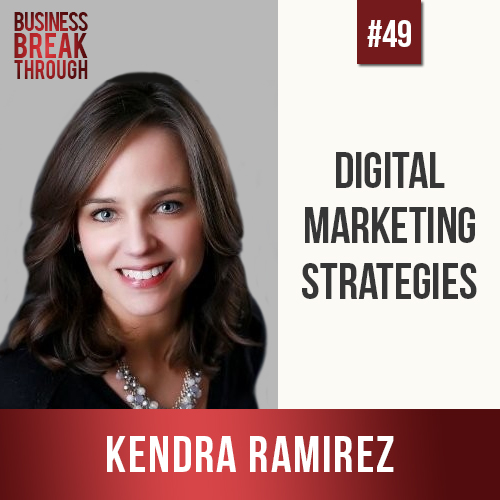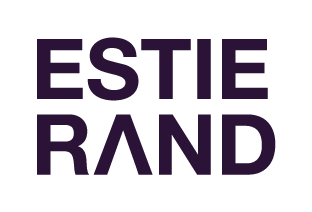Feeling confused on how to build and implement your digital marketing strategy? Kendra Ramirez is a seasoned expert in building digital marketing strategies and has been working in digital for over 15 years. In this episode she explains, in full detail, the ins and outs of digital marketing strategy, starting with an assessment of your business all the way through to creating your ad and testing it with analytics.
Teaser:
My Guest: Kendra Ramirez
Kendra Ramirez is globally recognized as the face on the home page of LinkedIn.com, a John Barrett Entrepreneur Vision Award recipient, AMA Marketing Legend and a finalist for the Social Media Innovator of the Year. Since 2005, she has helped hundreds of organizations, including Fortune 500 companies, leverage digital technologies. Kendra has spent more than 15 years in technology companies as a change agent in sales, marketing and recruiting leadership for B2B customers.
Kendra is also a crazy sports mom who springs out of bed in the morning to conquer the world and annoys others who are not morning people.
Pivotal Moments:
In 2005 started working in the digital industry as a self-leader for a Fortune 500 company.
Was engaged mostly in training businesses in how to use marketing tools but realized that most businesses didn’t have the underlying strategy to use the tools effectively.
Decided to open her own digital marketing agency focusing on the strategy as well as the tools.
Took her business plan to three coaches and mentors who unanimously told her that digital marketing was a fad and would soon disappear.
Was convinced that digital marketing had a strong future, so opened her business anyway.
Was doing well and making sales, but the lack of a self-sustaining sales cycle lead to the death of business when the recession hit in 2008.
Took a W2 job as a digital marketing consultant and trainer which gave her some great experience and skills.
Re-opened her own agency three years ago, getting back to her W2 job salary within two months.
Kendra is now running a full digital agency providing websites, social media management, lead generation, social ads and more. She employs eight full time staff, ten full time freelancers and is averaging at 22 meetings a week for herself!
The Advice:
Real Marketing Experts
Too often when people seek out marketing help, they end up with the blind leading the blind, and no one knows that they can’t see. There is no governing body deciding who can call themselves a marketer, so many people have taken short courses in marketing and feel qualified to call themselves a “marketing professional.”
A real marketing expert needs to know about the depth of marketing strategy and how businesses run. The best way to ensure that you don’t end up being led by the blind, is to make sure that you can see. This means learning the basics of marketing strategy so that you can ask the right questions and at least recognize when someone knows what they are talking about.
Starting Up
Two important pieces of advice for people starting their own business:
- Read The E-Myth. You will wish you had read it sooner!
- Don’t be put off by people who tell you it won’t work. If you believe in it and have a good reason why it should work, go for it and surprise everyone else!
Sales Cycle
Most people are aware of the sales funnel where you get attention and try and convert that attention into sales. But for real business success, you need to have a sales pyramid as well. A sales pyramid is the process of converting existing sales into more sales, creating a self-sustaining sales cycle. This happens when your existing customers either come back to buy more, or they love you so much that they refer other customers to you. Without a sales pyramid, you have to continually invest more and more time and money into getting new customers which can exhaust both your energy and your business resources.
Scale or Bail
The only products or services that you offer when you want to scale are those that you can produce in bulk. There are many products or services that you could provide if customers request them, but they involve more effort and cost you more money and you can’t easily scale them. These are the products or services to bail out of and simply not provide at all.
Digital Strategy
Digital marketing strategy means having a goal of what you want your digital marketing to do for you, and then creating a plan of how you will reach that goal. There are five steps to creating a digital marketing strategy:
Step One: Assessment
The first step of creating a digital strategy is assessing the following three areas:
- Digital Assessment: Look through your digital assets such as your website, social channel and your web presence (what shows up when you search for yourself on Google) to see what needs cleaning up. For example, maybe your branding is not consistent across all digital assets or it is not clear what you provide.
- Competitive Assessment: Look through the digital assets of three to five competitors looking at metrics such as the platforms they are using, the frequency of their content, how much engagement they are getting and any special products/ services that they are offering.
- Client Opinions: Ask a few clients or trusted contacts to give you their opinions such as their initial emotion when they look at the home page, or their initial impression of what your main offering is.
Step Two: Set and Define Goals
Now that you know where you are standing and what your strengths and weaknesses are, you need to set your goals. Goal setting can be broken down into four steps:
- Set a general area to focus on, for example, do you want to focus on lead generation, recruitment marketing, reputation management or brand awareness.
- Decide on key metrics i.e. what data gives you detailed information and understanding in the area that you want to work on.
- Take a baseline of all key metric data to see where you are currently holding.
- Using the key metric data and your current position, decide on a goal of what you want your future positioning to be.
Step Three: Planning the Campaign
Next you need to build a campaign to help you reach that goal. To successfully build a campaign, you need to layout all the content and plan in advance exactly how it will run. This includes:
- The tone of the content.
- The types on content- blogging, guest blogging, ads, e-newsletters etc.
- The brand archetype.
- Frequency of posts
- Channels
- Who will own the content? Will it be owned internally or will there be a partner ghosting for you?
You then need to map out all the content over a 30 day period (a content calendar can help).
Step Four: Analytics & Testing
You are ready to launch the campaign and then straight away dig into analytics.
Analytics
In marketing, nothing is guaranteed. Any marketer who guarantees results is either stupid or lying. The job of a marketer is to help you set up a campaign correctly, but that doesn’t guarantee that it will work. Therefore, when launching a campaign, it is crucial to test what is working and what is not using analytics.
Using analytics is a little like a horse race where all the horses are set up at the start line, then the race starts and everyone watches carefully to see which horse is running the fastest.
Digital marketing works the same way. You set up your pieces of content and launch them. Now test to see which ones are working the best. Once you have figured out which ones are winning, turn off all the other ones and invest your money in the winners.
Testing
To really understand what works and what doesn’t, you need to test six variations of each piece of content e.g. a Facebook Ad. The important point is to change just one one thing in each ad so you can understand what specifically attracts your audience. For example, just change the image, or just change the headline and see if that impacts on results.When still in the testing stage and figuring things out, you don’t want to spend a lot of money. To keep testing financially viable, set a budget of $500 a month. Once results start happening, you then can up the ad spend.
Step Five: Rinse and Repeat
Once you have a working campaign, keep in mind that things keep shifting. You especially need to keep an eye out for what competitors are doing and for new innovations in the industry.
To avoid complacency and to keep yourself up to date, have a monthly meeting in which you take a 30 day look back to see what worked and what didn’t, and then 30 and 60 day forward planning, pointing out things to be aware of going forward.
The Struggle:
For Kendra, 2018 was an intense year devoted to scaling her business. In order to do this, she needed to take a close look at every step of her systems and processes to find efficiencies that could be brought in to her processes and also find gaps that she was missing that would stop her from scaling. However, this posed a problem for Kendra since she is creative and idea focused, not process and detail orientated. How could Kendra scale her business by improving her business processes given her personality and nature?
The Breakthrough:
Kendra found exactly what she was looking for in the form of a database system. Kendra had been using Trello as her database software before she discovered ClickUp. She made the switch and has been incredibly grateful that she did! With the new system she can now link items to tasks so that the database itself changes the project workflow and timeline in line with when tasks are completed, in effect removing bottlenecks and creating automatic efficiencies.
Quotes:
Live, learn and pass it on.
Resources and Links:
Did you enjoy this episode? Then subscribe to my podcast on iTunes, so you can get automatic updates whenever another episode goes live (and you will be helping me get to #1 on iTunes, making us all cooler in the process!)


